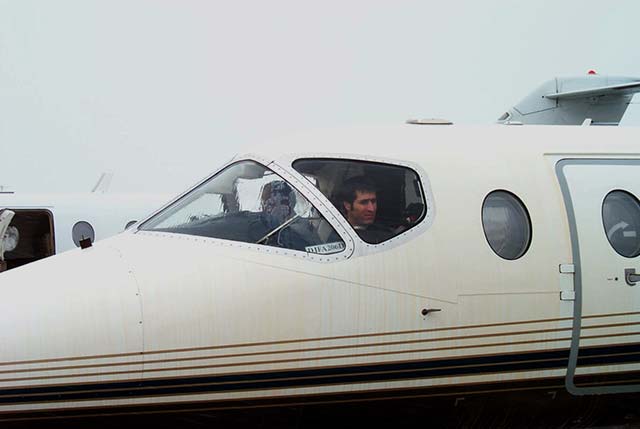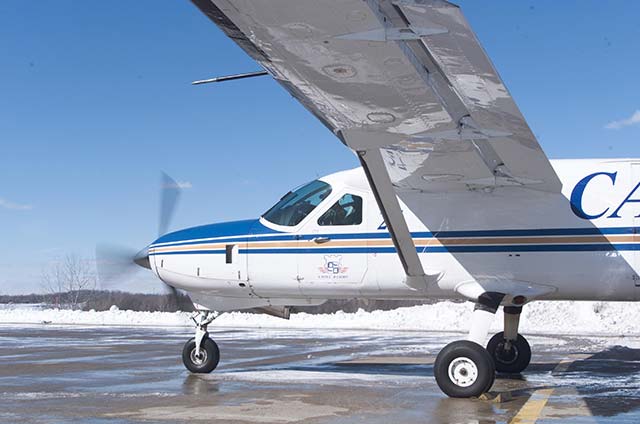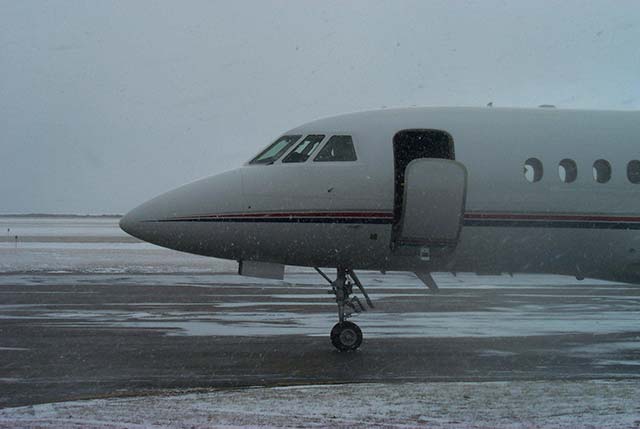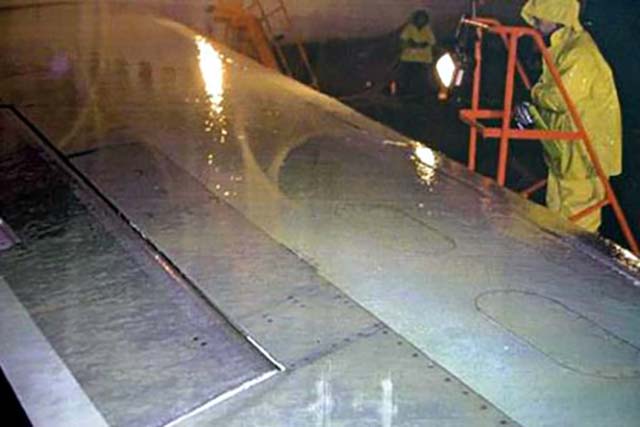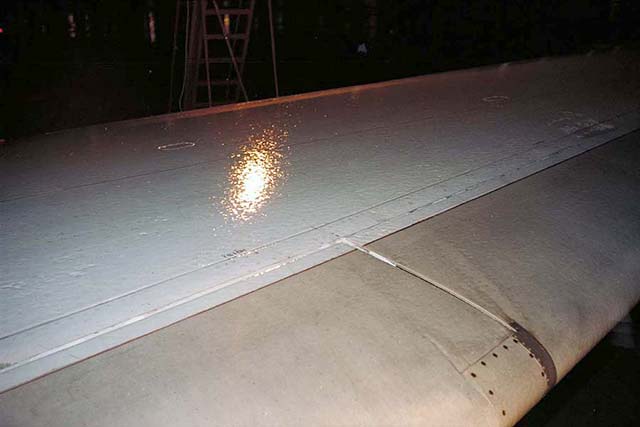A Pilot's Guide to Ground Icing
Module V - Anti-Icing Operations
How to keep it off
Section: Final Go/No-Go Decision
Start This SectionFinal Go/No-Go Decision Anti-Icing Operations
No matter what procedures you followed, what fluids you used, or how long you've been waiting to depart, the bottom line is the same: Do not depart unless you are SURE that your aircraft is ice-free. Continuously monitor for anything that might reduce your HOT. And, immediately prior to take-off, again inspect the aircraft to be sure that the anti-icing fluid has not failed and the aircraft is still free from frozen contamination.
Begin with a thorough visual inspection. In some aircraft under some conditions, you may be able to conduct a satisfactory pre-takeoff inspection from the cockpit. In other aircraft or under other conditions, you may need to go into the cabin. In other cases, you may need to exit the aircraft to be reasonably certain that the fluid has not failed.
Pilots Chris Cerny & Tom Schultz – pre-takeoff contamination check
Final Go/No-Go Decision Anti-Icing Operations
If you have any doubts, exit the aircraft and conduct a tactile inspection. At a busy airport, ATC often will accommodate a request to move out of the takeoff queue to conduct this sort of inspection, but you may need to taxi back. Do whatever you must to make sure the aircraft is free from frozen contaminants before you take the runway.
Caution
Related Information
DENVER, CO – USA
NOVEMBER 15, 1987
DC-9
The aircraft was on a flight (Flt No 1713) from Denver, Colorado to Boise, Idaho. The weather was IMC, with a 500 ft ceiling, 0.5 miles visibility in fog and moderate falling snow and an OAT of -2 degrees C. Following a 27 minute delay between de-icing and departure, on take-off the aircraft was over-rotated by the first officer and control was lost. The aircraft stalled and impacted the ground some 8,000 ft off the right side of the runway.
Company procedures called for repeat de-icing when in icing conditions if a delay exceeds 20 minutes. Confusion between the tower and the flight crew due to procedural errors resulted in the delayed take-off clearance. During the delay, the aircraft accumulated an unknown amount of contamination during the snowstorm. The de-icing fluid may have been diluted by the precipitation so that re-freezing was possible.
Final Go/No-Go Decision Anti-Icing Operations
If Precipitation Begins During Taxi
If any kind of freezing precipitation begins after you commence taxiing, and you haven’t anti-iced, your best course of action is to taxi back to de/anti-ice your aircraft. Don’t be fooled by freezing rain and freezing drizzle (or rain/drizzle at near freezing temp-eratures), which usually appears wet from the flight deck, but may have in fact frozen to adhering clear ice. A tactile check is the only way to assess the con-dition of your critical surfaces. If there is any doubt as to whether contamination is adhering to your aircraft, taxi back to de/anti-ice.
Further Information
In turboprop or piston airplanes, anti-icing fluid may be less effective immediately behind the propellers.
In the case of front-mounted single engine aircraft, the prop wash distorts the accumulation of frozen precipitation on the cowling and windscreen.
For these reasons, you should use another aircraft surface as a representative surface for your pre-takeoff and pre-takeoff contamination checks.
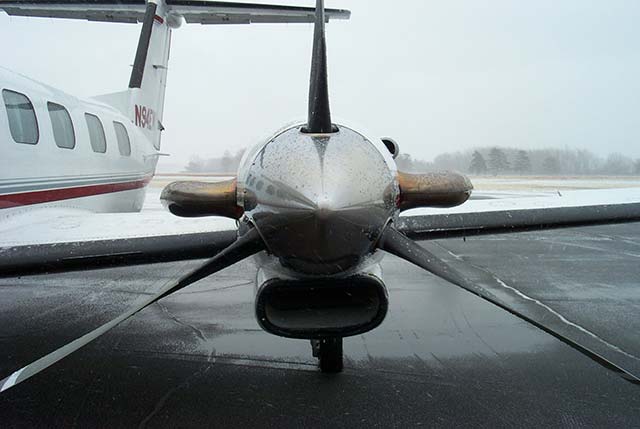
Mike Bakker & Dave Steinbruegge: Pilots describe inability to climb after takeoff
Final Go/No-Go Decision Anti-Icing Operations
Some operators have special inspection procedures that have been developed in cooperation with manufacturers and regulatory agencies. These will generally be part of an approved icing program or Air Operator’s Certificate (AOC). If this applies to you, follow your specified procedures.
Typically, the inspection procedure depends on whether or not the HOT has been exceeded. Within the HOT (when the fluids should be functioning), a visual inspection may be allowed. If the HOT has expired (when the fluids are expected to have failed), a more thorough visual and/or tactile check will be required.
Further Information

FAA Guidance from AC 120-60B "Ground Deicing and Anti-icing Program"
Pretakeoff Check: "A check of the aircraft's wings or representative aircraft surfaces for frozen contaminants. This check is conducted within the aircraft's HOT and may be made by observing representative surfaces from the flight deck, cabin, or outside the aircraft, depending on the type of aircraft and operator’s FAA-approved program. (§3.e)
Pretakeoff Contamination Check: A check (conducted after the aircraft’s HOT has been exceeded) to ensure the aircraft’s wings, control surfaces, and other critical surfaces, as defined in the certificate holder's program, are free of all frozen contaminants. This check must be completed within 5 minutes before beginning takeoff and from outside the aircraft, unless the certificate holder’s FAA-approved program specifies otherwise." (§3.f)
See also:
FAA FAR 91.527 Operating in icing conditions
FAA FAR 135.227 Icing Conditions: Operating Limitations
FAA FAR 125.221 Icing Conditions: Operating Limitations
FAA FAR 121.629 Operation in Icing Conditions
SAE ARP4737 Aircraft Deicing/Anti-icing Methods

Transport Canada Guidance from P 14052E, "Guidelines for Aircraft Ground Icing Oprations"
Pre-takeoff Contamination Inspection - within HOT range: “Transport Canada considers that when the time that has expired since anti-icing is within the range of time chosen by the Pilot-in-Command for the conditions present and covered by the Guidelines, there is a requirement to conduct an inspection prior to takeoff. This inspection will usually be conducted from within the aircraft and may be an inspection of one or more of the representative surfaces of the aircraft. The inspection must be described in the Air Operators Approved Ground Icing Program." (§11.1.6)
Pre-takeoff Contamination Inspection - HOT range exceeded: “Transport Canada considers that, when the time that has expired since anti-icing is greater than the largest value in the range of time chosen for the conditions present and covered by the Guidelines, there is a requirement to conduct an inspection of the critical surfaces prior to takeoff. This inspection must be conducted from outside the aircraft. This inspection must be described in the Air Operator’s Approved Ground Icing Program.” (§11.1.7.5) Note: However, Transport Canada cautions users that Type I fluids have short HOT performance, and fluid failure can occur suddenly after the HOT has expired.If using Type I fluids and the HOT has been exceeded, then the prudent action would be to re-deice or delay departure until conditions improve.
See also: CARs 602.11 para (2) & (4), GOFR 622.11 para (6.3), (7.1.2) and (7.1.3)
If you are trained in HOT guidelines:
When the weather conditions have not changed from your estimates of HOT & you are:
- Less than the lowest time in the HOT cell... Takeoff.
- Between the HOT values... Visual inspection from inside the aircraft.
- Beyond the HOT values... External tactile inspection or return to de/anti-ice again.
If you are NOT trained in HOT guidelines:
- You must conduct an external tactile pre-takeoff contamination inspection immediately prior (within 5 minutes) to takeoff.

CAA Guidance from "AEA Recommendations for De/Anti-icing of Aircraft on the Ground"
Pre-takeoff Check: "The commander shall continually monitor the environmental situation after the performed de-icing/anti-icing treatment. Prior to take-off he shall assess whether the applied holdover time is still appropriate. This check is normally performed from inside the flight deck." (§3.12)
Pre-takeoff Contamination Check: "A check of the critical surfaces for contamina-tion. This check shall be performed when the condition of the critical surfaces of the aircraft cannot be effectively assessed by a pre-takeoff check or when the applied holdover time has been exceeded. This check is normally performed from outside the aircraft. The alternate means of compliance to a pre-takeoff contami-nation check is a complete deicing/anti-icing re-treatment of the aircraft." (§3.13)
See also: JAR OPS 1.345 (b)
ANO Article 43 (g)
Final Go/No-Go Decision Anti-Icing Operations
Identifying Fluid Failure
Usually, failed fluids are readily recognized when they transition from a glossy to a dull, opaque appearance. However, in freezing rain or freezing drizzle, there is only a subtle change in appearance. In these conditions, the surface will still appear glossy or wet following fluid failure. A tactile check is usually required to tell the difference.
Looking at the top of the wing from the flight deck to check for fluid failure is difficult in high or swept wing configurations. Dusk/night can also interfere with your ability to determine the condition of the fluid. Regardless, you must be able to recognize fluid failure.
